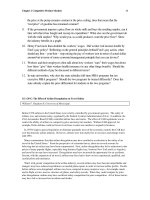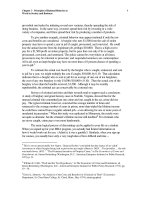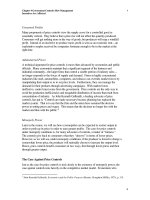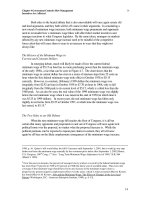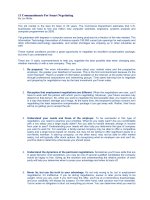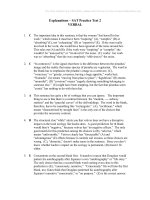Tài liệu Guidelines for Developing Traffic Safety Educational Materials for Spanish-Speaking Audiences doc
Bạn đang xem bản rút gọn của tài liệu. Xem và tải ngay bản đầy đủ của tài liệu tại đây (1.74 MB, 100 trang )
Developed by the
Educación de seguridad en el tránsito/Education in Traffic Safety project,
Education Development Center, Inc.
With funding from
AAA Foundation for Traffic Safety
FIA Foundation for the Automobile and Society
National Highway Traffic Safety Administration
Guidelines for
Developing Traffic Safety
Educational Materials
for Spanish-Speaking
Audiences
F4008 (Apr 2003)
Para determinar
si su hijo debería
usar un asiento
“Booster”
5 Preguntas
La Administración Nacional de Seguridad de Tránsito y AAA recomienda
que su hijo continue usando su asiento “Booster” hasta que tenga 4'9"
de altura y ocho años de edad. Pero cómo determina usted si ya llegó el
momento para que su hijo pueda sentarse en el asiento de su automóvil
con el cinturón de seguridad abrochado?
Debería su hijo usar un asiento “Booster”?
Responda a éstas 5 preguntas:
SI NO
1
Se sienta su niño completamente contra el
respaldo del asiento del auto?
■ ■
2
Se doblan cómodamente las rodillas del
niño a la orilla del asiento del auto?
■ ■
3
Cruza el cinturón de hombros entre el
cuello y el brazo?
■ ■
4
Está el cinturón de caderas colocado lo
más bajo posible, tocando la parte superior
de las piernas?
■ ■
5
Puede mantenerse su niño sentado así
durante todo el viaje?
■ ■
Si usted respondió “no” a una de éstas preguntas, su hijo aún necesita usar
el asiento “Booster” para su seguridad. A los niños les gusta la cómodidad
de los asientos “Booster” y además, pueden mirar por la ventana!
Los asientos “Booster” son para los niños grandes!
Fuente de información:
SafetyBeltSafe
U.S.
A.
-i-
Guidelines for Developing
Traffic Safety Educational Materials
for Spanish-Speaking Audiences
Developed by the Educación de seguridad en el tránsito/Education in Trafc Safety project,
Education Development Center, Inc.
With funding from
AAA Foundation for Trafc Safety
FIA Foundation for the Automobile and Society
National Highway Trafc Safety Administration
May 2006
-ii-
Web site URLs: All Web site URLs were veried at printing time. However, Web sites are
continually being changed and updated. If a URL does not work, please use your Web
browser to search for the resource.
-iii-
The Project and Authors
Guidelines for Developing Trafc Safety Educational Materials for Spanish-Speaking Audiences was
developed as part of Educación de seguridad en el tránsito/Education in Trafc Safety (EST), a
two-year project conducted by Education Development Center, Inc. (EDC), in Newton,
Massachusetts. EST’s goal was to foster the development of effective trafc safety
educational materials to serve the growing Spanish-speaking population in the United
States.
The objectives of the project were to:
• Collect and describe existing Spanish-language trafc safety educational materials
• Develop these guidelines for creating culturally and linguistically appropriate educa
-
tional materials for Latinos (this document)
• Use these
Guidelines to develop one sample educational material (reproduced in
Appendix E)
• Develop a Web site that contains these
Guidelines and trafc safety resources for Span-
ish-speakers
Project Staff
Erica Streit-Kaplan, MPH, MSW
Project Manager
Magda Rodríguez, MA
Senior Research Assistant
Viviana Cataño-Merino, BA
Research Assistant
Chris Miara, MS
Technical Advisor
Acknowledgments
This document was produced with funding from the AAA Foundation for Trafc Safety
(AAAFTS), the FIA Foundation for the Automobile and Society, and the National
Highway Trafc Safety Administration (NHTSA). We would like to thank J. Scott Osberg,
J. Peter Kissinger, Brian C. Tefft, and Fairley Mahlum at AAAFTS, Bella Dinh-Zarr at
AAA, Robin Mayer and Gabriel Cano at NHTSA, and Carlos Arce at NuStats. Susan
Gallagher and Julie Ross of EDC wrote the proposal and obtained funding to carry out
the work. The guide was edited by Jennifer Davis-Kay of EDC and Joy Sobeck. The
graphic designers were Ronnie DiComo and Emily Passman of EDC.
-iv-
Brandon Alvarez-Montgomery of The Media Network, Inc., and Irene Rodríguez and
Josie Garza of National Latino Children’s Institute shared their experiences and insight.
We would like to thank the members of Western Massachusetts Educación de seguridad
en el tránsito (WEST), a community advisory group in Holyoke, Massachusetts, for their
input and participation as we developed a fotonovela using a draft version of these Guidelines.
Finally, we greatly appreciate the time and energy that members of the EST National
Work Group and Expert Review Panel devoted to carefully reviewing this guide.
-v-
Contents
INTRODUCTION 1
Overview 1
Why We Created these Guidelines 2
Intended Audience for the Guidelines 3
Critical Expertise You Need 4
How We Developed the Guidelines 4
Organization of the Guidelines 5
Denitions 6
Core Principles 7
RESEARCH AND PLANNING 9
1. Identify Key Partners 11
2. Understand Your Trafc Safety Topic 14
3. Understand Your Audience 16
CREATING MATERIALS 24
4. Develop Your Message and Content 25
5. Use Accurate, Simple, and Appropriate Language 31
6. Use Culturally Appropriate Format and Graphics 37
7. Solicit Feedback from Your Audience and Partners 41
DISSEMINATION AND EVALUATION 44
8. Effectively Disseminate Your Material 45
9. Evaluate and Review Your Material 46
ADAPTING EXISTING MATERIALS 50
APPENDICES 56
Appendix A: People Involved in Developing the Guidelines 57
Appendix B: Resources 59
Appendix C: Glossary of Spanish Trafc Safety Terms 67
Appendix D: WEST Story and Development of a Fotonovela 74
Appendix E: Fotonovela Conductores y Peatones: Manténganse Alerta.
Sean responsables. La Seguridad es responsabilidad de TODOS.
82
Appendix F: Adapting the Fotonovela for a Broader Audience 85
REFERENCES 88
-1-
INTRODUCTION
Overview
These Guidelines were developed as part of a larger project, Educación de seguridad en el tránsito/
Education in Trafc Safety (EST). The goal of the project was to foster the development
of effective trafc safety educational materials to serve the growing Spanish-speaking
population in the United States.
Guidelines for Developing Trafc Safety Educational Materials for Spanish-Speaking Audiences is
designed for organizations seeking to create, or to help others create, culturally and
linguistically appropriate trafc safety educational materials for Latinos.
1
The process
outlined addresses primarily print materials such as brochures, posters, booklets, and
fotonovelas.
2
It can also be used to develop videos, public service announcements, and other
materials that promote safe driving, riding, walking, and biking.
These Guidelines cover the process of planning, creating, disseminating, and evaluating
an educational material. They are designed to ensure that the nal material meets three
criteria:
• The trafc safety information presented is accurate.
• The target audience is appropriately addressed.
• Principles of effective health communication are used.
The nine steps in these Guidelines represent an ideal, comprehensive approach to
developing a new material in Spanish. You should follow as many steps as your resources
allow. This process requires more staff, time, and money than simply translating the text
of an existing English material into Spanish. However, by following these steps you will
produce a material that is more likely to resonate with your audience and to change your
audience’s safety-related knowledge, attitudes, and behavior.
Because organizations have limited resources, you likely will need to decide which topic
or topics are most important for you to address by creating a new material. It is not
necessary for every organization to develop a Spanish-language material on every trafc
safety topic. Instead, you can work with other groups, share materials, and adapt one
another’s effective Spanish-language material for particular uses. Ultimately, creating a
few high-quality materials that resonate with the intended audience is likely to prove
more effective than producing a greater number of low-quality materials.
1
We use the term Latino to refer to all people living in the United States who come from, or whose ancestors
came from, Spanish-speaking regions of the world. See pages 6–7 for more information.
2
See page 38 for a denition of this term.
-2-
Finally, realize that producing a brochure and putting it on a shelf or on your organization’s
Web site is unlikely to make a widespread and lasting impact on the behavior of the people
whom you’re trying to reach. The materials that you produce will be most effective if they
are used as part of a broader and more sustained effort, by your organization and/or
your community partners, to promote health and safety.
Although most of the demographic and cultural information in this document is specic to
Latinos, the nine steps and much of the expert advice can be used to develop educational
materials for other populations or materials that deal with other safety and health topics.
Why We Created these Guidelines
Motor vehicle crashes are the leading cause of death for Latinos between the ages of
one and thirty-four (CDC 2005). Although Latinos have population-based trafc-related
fatality rates similar to those of the general population, available data from travel surveys
suggest that Latinos travel less than the general population, however, they experience
greater risk when they travel. Baker (1998) reported this nding for Hispanic children and
adolescents, and Braver (2003) reported similar ndings for the adult men of Hispanic
origin. Braver’s ndings also pointed to lower socioeconomic status as an important risk
factor for all races and ethnicities, and noted that socioeconomic status fully explained
“the excess mortality risk among Hispanic men relative to whites” (2003). Other studies
have found that Latino children are less likely to use bicycle helmets, child safety seats,
and safety belts (The Trafc Safety Center Newsletter 2003; Womack 2001; Matteucci
1995). Latinos have higher per-capita pedestrian death rates than the U.S. population as
a whole (CDC 2005), and a study in California found the pedestrian injury rate among
Latino children to be twice that of non-Latino white children (Agran 1998). Several
studies indicate that alcohol plays a role in a greater proportion of fatal crashes involving
persons of Hispanic origin than in crashes involving non-Hispanic whites (Voas 1998;
Voas 2000; NHTSA 2002; Harper et al. 2000).
Reducing the toll of trafc injury requires a comprehensive approach that includes the
“three Es” of injury prevention: education, engineering, and environmental modications
(e.g., building safer pedestrian walkways, eliminating pavement edge drop-offs, etc.), and
the enforcement of effective laws. It is widely recognized that public health-and-safety
efforts have greater success when they are tailored to the cultural norms, preferences,
history, and experiences of the specic groups that they seek to inuence. Several studies
specically discuss the importance of cultural appropriateness in programs and materials
that address trafc safety issues among Latinos (Schiff and Becker 1996; NHTSA 1995;
Harper et al. 2000; Agran 1998). Although many materials are available in Spanish, at
least one study has revealed deciencies in the accuracy and cultural appropriateness of
many of these materials (Ross, Gallagher, and Miara 2002).
-3-
Although educational materials are only one component of a comprehensive trafc safety
program, they are an important element if they are accurate and effective. Consider the
following scenario:
Pedro, a young child, gets his rst bicycle and is excited to ride it. His parents are recent
immigrants to a large city in the United States, and a local health center gives them a brochure
in Spanish about preventing bike injuries. The material is hard for them to understand.
For example, comfort padding, the English technical term that describes the padding in a
helmet, is translated into Spanish as acojinado de confort, but it is not explained. The
type of Spanish used is unfamiliar to Pedro’s parents, and the brochure is written at a ninth-
grade reading level, much too high given their limited literacy. The pages are lled with long
paragraphs, and the printing is small. There are no pictures illustrating the proper way to use
a helmet; the brochure’s only picture shows a child riding a bike in a community that looks
nothing like Pedro’s urban environment. Finally, the information about how to adjust the helmet
straps is incorrect.
In their home country, Pedro’s parents never saw children using helmets. They want to keep their
son safe, but they don’t know what the information in the brochure means. As a result, Pedro
rides his bicycle without a helmet, risking a head injury and violating his state’s helmet law.
This scenario illustrates the challenges inherent in developing materials for non-English
speakers from other countries. If your materials are to inuence attitudes and change
behavior, they must consider cultural and linguistic factors, contain correct information,
and employ principles of effective health communication.
Intended Audience for the Guidelines
The vast majority of trafc safety materials for Latinos are produced by English-speaking
or bilingual (English-Spanish) staffs of state or national organizations. Therefore, the
primary audience for these Guidelines is English-speaking or bilingual staffs of state or
national organizations that wish to produce trafc safety educational materials for Spanish-
speakers living in the United States. Most of the recommendations in the Guidelines relate
to the development of new materials, but we also discuss how to modify existing English
and/or Spanish materials.
Although local organizations are not the primary target audience of the Guidelines, such
groups will also nd them useful. Local organizations will learn how to ensure the accuracy
and appropriateness of an item for their audience and how to modify for their particular
community materials that were developed for a broader audience.
-4-
Critical Expertise You Need
Developing an effective material for a Latino audience requires knowledge of trafc
safety, Latino communities, and health communication. If you are a trafc safety
or injury prevention professional, make sure you have expertise in the area for which
you want to develop a material (e.g., pedestrian safety or child passenger safety), and
then nd partners who have an understanding of the Latino audience and expertise in
health communication. Similarly, if you are an expert on Latino issues but you or your
organization does not have expertise in trafc safety or health communication, collaborate
with specialists in these areas. Finally, if you are a health communication expert and you
do not have specic expertise in trafc safety and/or Latino issues, work with experts in
those areas.
How We Developed the Guidelines
Project staff took the following steps to develop and rene these Guidelines:
1. We collected existing Spanish-language trafc safety materials and conducted a tele
-
phone survey of the developers of those materials. This enabled us to identify positive
examples of materials and to capture lessons learned by the developers.
2. We examined existing research and national guidelines on cultural competency, in
particular those of the National Center for Cultural Competence and the Educa-
tion Resources Information Center (ERIC) Clearinghouse on Elementary and Early
Childhood Education.
3. We convened the EST National Work Group, a group of national experts in trafc
safety, Latino issues, and health communication, and took advantage of their expertise
throughout the development process. We also relied on a panel of expert reviewers
(see appendix A).
4. We pilot-tested and subsequently rened the recommendations by convening a com
-
munity advisory group (WEST) in one community and working with its members to
create a model educational material following the steps in an earlier draft version of
the Guidelines. The model material is in appendix E.
-5-
Organization of the Guidelines
The Guidelines are organized into three main sections: Research and Planning, Creating
Materials, and Dissemination and Evaluation. Each section includes specic action steps
and supplemental information. A fourth section, Adapting Existing Materials, provides
guidance on adapting existing materials for different audiences and on updating or
improving materials. We recommend reading the entire document before you begin to
develop your material.
In the Guidelines you will nd four different types of information, each denoted by its own
icon:
Basic steps: These are the nine steps you should follow in developing and dissemi-
nating a culturally and linguistically appropriate material for Latinos.
Resources: These include Web sites, research articles, key reports and documents,
and relevant organizations and contacts. They are located in the appendices.
Quotes and advice: These are collected from several sources:
• Respondents to the EST telephone survey of developers of Spanish-language
trafc safety materials (“EST Survey”). These developers were interviewed by
EDC staff about the process they used to develop materials and the lessons they
learned.
• Members of the EST National Work Group, who share their knowledge about
the health-and-safety-related experiences, attitudes, and practices of Latinos.
• Staff from several national organizations and marketing rms who have experi
-
ence working with community groups as part of the process of developing ma-
terials. These include EST staff who worked with the WEST group to develop a
material.
• Researchers who have conducted focus groups and surveys related to trafc safety
and injury prevention for the Latino community
Samples of actual materials: These exemplify the recommendations in the
Creating Materials section of the Guidelines.
-6-
Definitions
Cultural appropriateness: “The ability to relate and communicate effectively when
individuals involved in the interaction do not share the same culture, ethnicity, language,
or other salient variables” (Santos and Reese 1999).
Latino: In these guidelines, Latino is dened as people living in the United States who
come from, or whose ancestors came from, Spanish-speaking regions of the world. The
term Hispanic may be more familiar; however, based on advice from several sources, we
use Latino in these Guidelines because it is considered to be more inclusive. Furthermore,
many national and federal initiatives refer to Latinos instead of Hispanics.
Debate: Hispanic or Latino?
There is no consensus in the U.S. about what term to use for people who come from
Spanish-speaking countries or whose ancestors did. The following excerpts describe the
debate.
The Tulane Hispanic Health Initiative states:
Today, the term Hispanic is used to include all kinds of persons from
Spanish origin, [but] for some people in the United States, Hispanic is a
more inclusive term because it does not [exclude people] who are from
Spain or belong to countries whose language is not Spanish such as Brazil,
Haiti, etc.; Hispanic is also a category used by the U.S. National Bureau
of Census to refer to the different groups of Latinos living in the United
States. Also, the National Institutes of Health prefers to use the term
Hispanic origin more often than the Latino term. From this perspective
the term Hispanic is widely used to write technical reports, and grants
proposals; in other words, Hispanic is used as a more academic/technical
term. On the other hand, Latino is probably the most popular term used
by non-prot organizations, public health and medical professionals,
newspapers, and popular magazines, to describe [Spanish-speaking]
people living in the United States (Tulane Hispanic Health Initiative
2002).
In “Hispanic or Latino?” Lynet Uttal of the University of Wisconsin–Madison writes:
The term “Hispanic” has been widely criticized as a “government
invention” that falsely homogenizes diverse groups of people. The major
objection to this term is that it lumps together too many diverse groups,
losing sight of distinctions between groups such as Mexican Americans,
Puerto Ricans, and Cuban Americans. Another objection is that it
emphasizes the European culture and ancestry and masks the African
and indigenous cultures that are also part of the history of many of the
-7-
groups included under this umbrella term. . . . Despite these objections,
the term has become popularly used by individuals to self-identify. . . .
[The] term “Latino” is the most apolitical, generally accepted term
you can use. This use of “Latino” covers all the people from Central
and South American countries plus Puerto Rico, Cuba, Costa Rica,
Dominican Republic, but not Spain (Uttal n.d.).
Core Principles
EST staff and the Work Group agreed on a set of principles to steer the development of
the Guidelines:
• To be most effective, developers should collaborate with appropriate partners and
stakeholders throughout the process to ensure that the materials resonate with the
audience, resulting in a change in behavior.
• Community input is essential in creating educational materials. Developers must col
-
laborate with community-based partners throughout the entire process of develop-
ment and dissemination. Developers must also solicit input from potential users of the
material via focus groups, pilot testing, and other measures. Although Spanish-speak-
ing professionals can provide useful guidance, the input of the actual audience is key.
Professionals are likely to be more educated and acculturated than a typical member
of the target audience; their preferred word choice, language, and style may not re-
ect those of the audience.
• Developers must be mindful that Latinos in the United States are a diverse group.
Latinos come from many different places and have differing levels of education and
literacy skills. Some Latinos live in homes where English is the primary language, oth-
ers reside in Spanish-speaking households, and others use both languages at home.
Religions, beliefs, length of time spent in the United States, and in some cases, legal
status, also vary widely. Just as no single English educational material will be effective
with all English-speakers, no single Spanish educational material will be effective with
all Spanish-speakers.
• Acculturation to American norms occurs along a continuum. Individuals may be ac
-
culturated in some ways (English language ability, American dress, etc.) yet may prefer
to receive health education information from within their own community. For ex-
ample, some people who have lived in the United States for many years and appear to
be very acculturated may get their news from Latino media sources rather than from
mainstream American media.
• Whether creating new materials or adapting existing ones, developers must ensure
that the materials use words that the audience can understand and must ensure that
the materials are in tune with the audience’s values and culture. Creating original
materials, in Spanish, for the specic audience, is the best way to ensure this.
-8-
• It is a waste of money, time, and other resources to create materials that do not reso-
nate with the audience; this often occurs when an English-language material is trans-
lated into Spanish without seeking audience feedback or adapting the message for that
particular audience. It is probably more cost-effective to create a few materials that are
culturally and linguistically appropriate for the target audience. Developers should be
selective in which topics they address, and collaborate and share materials with other
developers.
-9 9-
RESEARCH AND PLANNING
Before you begin to develop your materials, dene the scope of your work. Answering the
following questions will help you make key initial decisions:
1. What topic will you address and what audience will you try to reach?
To determine which topics need to be addressed, review data describing the most
prevalent types of trafc injuries and the groups most at risk. Dene the parameters
of the audience you intend to reach. For example:
•
Geographic locale: Do you intend to target a diverse Spanish-speaking population
across the county, or the population of your city or county? Does your target
audience
1
live in an urban area or a rural area?
•
Heritage: Is your audience primarily composed of persons of similar heritage, or
is it more heterogeneous? In the case of foreign-born persons, it is important to
consider both country of origin and whether persons come from an urban or a
rural background.
•
Age, gender, etc.: Do you intend to target young children, 16–17-year-old males who
are just beginning to drive, parents of young children, grandparents, mature
adults in general, or some other specic group dened by age and/or gender?
If you are developing a national material, your target audience is likely to be dened by
age and/or gender or by urban/rural locale, rather than by ethnic heritage. If you are
developing a material that is local in scope, your target audience is likely to be from a
particular country of origin. You may rene or expand your target audience as you move
through the process of research and planning and as you identify partners and groups
in particular need of educational materials. The Guidelines offer recommendations for
appropriately targeting both diverse and specic audiences.
1
The term target audience refers to the audience for which a material is intended.
-10 10-
How WEST Chose a Community
We selected Holyoke for several reasons: EDC was already familiar
with this community, having worked there on a previous project called
“Kids in the Back”; the community wanted to address trafc safety
issues affecting Latinos in their locality; and the project’s senior research
assistant worked in the area and had contacts with professionals and
residents who were interested in this project.
—EST staff
2. Can you use existing materials? Many Spanish-language materials on traf-
c safety topics already exist; you should examine these before deciding whether to
create something new. You can view the list of existing materials identied by the
EST project on the AAAFTS Web site (www.aaafoundation.org/projects/index.
cfm?button=EDCintro).
2
• If you decide to use an existing material, see the Adapting Existing Materials sec
-
tion of this document. It describes how to determine which aspects of an existing
material you may need to update or modify and how to revise the material so that
it will be effective with your target audience.
• If you decide to create a new material, follow the nine steps of the
Guidelines. The
rst three steps show you how to work with partners to research and understand
your audience, the topic, and the principles of effective health communication.
Why NHTSA decided to develop new materials rather than
adapt existing ones for a child passenger safety project
Recognizing Latino children are at great risk of injuries and deaths
from trafc crashes, NHTSA provided funding to the National Latino
Children’s Institute to develop a culturally and linguistically sensitive
program to increase child passenger safety device use by young Latino
parents and their extended families. Rather than translating or adapting
English language materials, the NLCI developed the “Corazón de mi
vida” (You are the heart of my life) program, which captures the essence
of child passenger safety for Latinos.
–Robin Mayer, NHTSA
2
Note that these materials have not been evaluated by AAAFTS.
-11-
To develop an accurate and effective trafc safety material, whether for a national or a
local audience, you need to be familiar with three subjects:
• Trafc safety
• Effective health communication
• Your target audience
Few people are experts in all three areas. Find partners who can provide background
and guidance in the areas outside of your expertise. You will draw on these experts
throughout the process of developing your materials. You may also decide to co-produce
the material with one or more of your partners, which can result in wider dissemination
of the materials and reduce costs. The following are the types of partners you will need.
Traffic Safety Experts
Although you may have extensive knowledge about trafc safety, you will probably benet
from consulting others with more specialized expertise in the specic subject area that
your material addresses, both to ensure the accuracy of the information presented in
your material and to enhance the credibility of your material. This is especially important
if you are developing a material that addresses a highly specialized topic, such as child
passenger safety. Requesting their input, and possibly their collaboration, at the outset,
will improve your material and build your ties to other organizations.
Health Communication Experts
You will need information about effective health communication techniques. These
techniques include the way you convey your message, the graphics and format, and the
way the materials are used (e.g., as part of a larger intervention or as a standalone effort).
Certain communication approaches and formats are especially effective for audiences
with low literacy. Information about these practices is available from organizations that
specialize in health education and/or those who develop materials for audiences with
low literacy or for those learning English as a second language. If your target audience is
national in scope, you might want to collaborate with communications or public relations
rms that routinely develop such materials for Spanish-speakers.
1
Identify Key Partners
-12-
Latino Culture Experts
You will need partners who are knowledgeable about Latino culture and health as
well as partners who can provide access to your target audience. If your audience is
broader in scope than a single community or a fairly homogeneous region, you will need
to understand multiple subcultures, (e.g., Mexican, Colombian, Salvadoran) to ensure
the nal product will resonate equally well among all subcultures within the intended
audience. You will nd it most helpful to collaborate with both national and local Latino
organizations and individuals.
• National Latino organizations understand effective ways to reach Latino audiences,
know about existing educational resources for those audiences, and are familiar with
examples of successful health-promotion strategies.
• Local Latino organizations include groups or agencies that serve the Latino commu
-
nity, such as health centers, local public health departments, youth-serving organiza-
tions, or service agencies. They also include local coalitions organized to address traf-
c safety and/or Latino health and safety issues, or individuals active in these areas.
WEST, the community advisory group we convened in Holyoke, Massachusetts, is
an example of a local Latino organization. The professionals and community leaders
who staff these groups may be able to provide relevant information about the com-
munities they serve, including information about social, economic, and environmental
factors (e.g., attitudes toward law enforcement, distribution of incomes, availability of
sidewalks) that may impact trafc safety needs and behaviors. In addition, you will be
able to work with these local leaders to solicit input directly from community residents.
You should draw on the knowledge of these local partners at least twice: at the begin-
ning of the development process (in “Step 2: Understand Your Audience”) and after
you have created a draft of your material (in “Step 7: Obtain Feedback from Your
Audience and Partners”).
How to Identify Local Partners
If you do not have existing relationships with local groups, consider the following strategies
to identify local partners:
• Ask your national Latino partner organization to draw on its community connec
-
tions.
• Contact your state or local afliates, chapters, or agencies and ask them to identify
local organizations that work with the community members you are trying to reach.
• Work with your health communications partner or marketing rm, which will likely
have experience in convening and soliciting feedback from community groups.
• Place notices on your electronic mailing lists, Web site, newsletters, and other venues
to solicit interested local partners.
Identify Key Partners
-13-
For a list of potential partners, see appendix B, step 1.
How Two National Organizations Identified Local Partners
Education Development Center, Inc.: To develop a
pedestrian safety material for Holyoke, Massachusetts, the EST senior
research assistant, who lived in Holyoke, spoke with colleagues and
others in the community who had expertise in trafc safety, public health,
and Latino health issues and invited them to participate in a community
advisory group. The group included representatives from the local SAFE
KIDS coalition, a trauma center, and community service agencies. This
is an example of bringing people together and developing your own
group.
The National Latino Children’s Institute (NLCI):
To develop
“Corazón de mi vida,” we collaborated with several
organizations. For trafc safety information, we worked with the
Governor’s Highway Safety Ofce in Texas, consulted the state child
passenger safety coordinator, and got help from our funding source,
NHTSA. To make sure that “Corazón de mi vida” would be
effective with a variety of groups across the country, we worked with
our Promesa partners. These are community-based organizations that
serve Latinos and are recognized as exemplary models of what works in
the Latino community. Promesa programs have shown that health and
social conditions can be improved when culturally appropriate strategies
are used for outreach and services. In our grants to community-based
organizations, we include small stipends for setting up focus groups,
community meetings, and child passenger safety events. We also ask the
staff in these organizations for feedback. They always tell us what they
think! Here’s the most important point: When developing partnerships it
is crucial that you allow your partners—small local organizations—to
be part of the solution. You have to use a peer-to-peer model. You can’t
just have the CEO of a company talking to the president of another
organization. It’s the workers in an organization who can tell you what
their clients want and need.
-14-
2a Review Data on the Scope of the Problem
Whatever your focus, you rst need to understand the scope of the injury problem and
the factors that contribute to it, both in general, and more importantly, for your specic
target audience. A variety of local, state, and national data is available on motor vehicle,
motorcycle, bicycle, and pedestrian injuries among Latinos, as well as on risk factors such
as impaired driving and nonuse of safety belts and helmets.
For selected statistics and data sources on the traffic safety problem among
Latinos, see appendix B, step2a.
2b Review the Research on Preventing Traffic Injuries
The information your material presents should be based on research about the
following:
• the actions that individuals can take to reduce their risk of injury
• the programs and policies that best facilitate those actions
Individual Actions
Your familiarity with the research on actions that individuals can take to reduce their risk
of injury (e.g., using safety belts, wearing bike and motorcycle helmets, using appropriate
child safety seats, or not drinking and driving) will ensure that your material provides the
most current and accurate information possible.
Effective Policies and Programs
Encouraging and facilitating safe behavior requires a variety of strategies, which are most
effective when used in combination. Strategies can be categorized according to the “three
Es” of injury prevention:
• Education: Educating the public and professionals on ways to reduce trafc injuries
(by means of materials, trainings, etc.)
• Engineering and environmental changes: Modifying the environment (e.g., making
roads safer or adding bike lanes) and making safety devices available (e.g., bike helmets
and child safety seats for low-income families)
• Enforcement and legislation: Enacting and enforcing laws (e.g., those related to safety
belt use and impaired driving)
For sources of information on effective strategies to reduce the risk of traffic
injury, see appendix B, step 2b.
2
Understand Your Traffic Safety Topic
-15-
Make sure that your research is current. For many trafc safety topics,
especially child passenger safety, recommendations change rapidly as
new research becomes available (e.g., guidance on the use of latches and
tethers to secure child safety seats and the importance of rear-facing seat
positions for infants). Also be sure to consider state and local trafc
laws, which change every year in some jurisdictions.
—EST National Work Group
2c Refine Your Topic
Through research and meetings with your partners in the early stages of the project,
you may decide to rene or modify your topic. For example, you might initially plan to
address underage drinking and driving, but then decide to expand your focus to include
other important topics that affect your audience, such as speeding and distracted driving.
Or, after nding that infant seats are already in wide use among your target audience but
booster seats are not, you might decide to narrow your focus from child passenger safety
in general to booster seats in particular. You might also need to rene your target age
group based on the groups you nd to be most at risk of injury.
-16-
Your material will be most effective if it appropriately targets the intended audience—
whether it is a narrowly dened group, such as Colombian American teenagers living
in East Boston, Massachusetts, or a heterogeneous national audience. You will need to
learn key demographic information about your audience and become familiar with the
audience’s knowledge, attitudes, beliefs, and experiences related to health and safety in
general and to trafc safety in particular. If your audience is diverse, you will need to
develop messages that resonate with all of the subcultures. If you are targeting a broader
audience, seek information from as many stakeholders as possible representing a variety
of groups.
Work with your local Latino partners to learn about your target audience in two ways:
• Obtain input from
members of your local partner’s organization. These individuals are likely
to be professionals and community leaders.
• Ask your local partner to contact
people in the community for their input. Conduct focus
groups, informal interviews, or surveys of community residents. You can carry these
out yourself, draw on students or community volunteers, or use the services of market-
ing or health education organizations that have used these methods.
It is important to note that once you conduct research to understand a particular audience,
that same research can be used to develop additional materials for the same audience.
This is especially important if you have budget constraints.
For resources on conducting focus groups, see appendix B, step 3.
Planning and Recruiting Focus Groups
Because EST staff did not have expertise in conducting focus groups, we
hired an organization that would train our bilingual staff in conducting
groups and assist us in developing questions and planning the groups
and would co-facilitate the sessions.
. . . To prepare for the focus groups, we followed these steps:
1. Determined our questions according to the information we wanted to
obtain
2. Contacted the WEST group to help recruit participants
3. Provided stipends of $25 for each participant, with an additional
$10 for people who needed child care assistance
4. Reserved three sites that were centrally located, accessible by public
transportation, and well known to residents
—EST staff
3
Understand Your Audience
-17-
Planning and Recruiting Focus Groups
Public relations rms plan and implement focus groups all the time.
Logistically, we start by developing criteria for participation (between
certain ages, years in the United States, income level, occupational
level, etc.). You could go to the YMCA and ask the rst 20 people you
see, but are they the clientele you’re looking for? We think about where
people meeting our criteria are likely to be found. Then we contact those
places—such as community-based organizations and churches—to
recruit and see if we could post a yer at their location or put
information in their newsletter.
We found that for every one qualied person we get at a focus group, it
takes three hours worth of time in calling and recruiting. It takes around
thirty hours to get a group of 10, but you need to secure 12 people
because some won’t show up. In addition to the time it takes to nd and
contact relevant organizations, it takes about a week of full-time work
for one staff person per focus group.
If you do focus groups at different times, like for pre- and post-testing,
you would want different people at each group so they have a fresh
perspective. Ideally, you want people who represent your target audience
and are not familiar with the issue or material.
—Brandon Alvarez-Montgomery, The Media Network
At the beginning of our projects, we do focus groups in various cities to
nd out what communities have most in common. You can never address
all their differences; you have to nd what the communities agree on.
We went to our Promesa partners for help setting up 12 focus groups, in
places as varied as the Bronx; Brownsville and Del Rio, Texas; and Los
Angeles. When we went there, they told us which countries the majority
of the audience came from. So we knew we were talking to different
groups. We had a set of questions we used with each group. We had our
child passenger safety consultant help us develop the questions: What
is the situation? Why aren’t kids in safety seats? What would change
people’s behaviors?
—National Latino Children’s Institute


